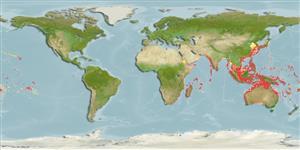Common names from other countries
Environment: milieu / climate zone / depth range / distribution range
Ecologia
marino; salmastro associati a barriera corallina; non migratori; distribuzione batimetrica 1 - 100 m (Ref. 9661), usually 1 - 50 m (Ref. 90102). Tropical; 42°N - 35°S, 18°E - 123°W
Indo-Pacific: Red Sea (Ref. 12541) and East Africa (Ref. 12484) to the Marquesan and Tuamoto islands, north to southern Japan, south to Lord Howe Island (Ref. 9710).
Size / Peso / Age
Maturity: Lm ? range ? - ? cm
Max length : 46.0 cm TL maschio/sesso non determinato; (Ref. 3141); common length : 40.0 cm TL maschio/sesso non determinato; (Ref. 9661)
Spine dorsali (totale): 0; Raggi dorsali molli (totale): 8-9; Spine anali 0; Raggi anali molli: 8 - 9. Cryptic coloring ranges from green and olive to orange with blue spots (Ref. 3141). Caudal fin rays 9-10 (Ref. 1602).
Inhabit inshore on coastal muddy or sandy habitats in still bays, and commonly found in harbours and estuaries. Small juveniles on protected shallow mudflats (Ref. 48637). Found in weedy areas near rocks or reefs. Juveniles often near river mouths and in brackish water. Adults are solitary, juveniles often form small groups (Ref. 1602). Large adults are shy (Ref. 48637). Feed on benthic invertebrates by blowing away the sand (Ref. 1602). Readily dried and used to make ornaments (Ref. 12484).
Life cycle and mating behavior
Maturità | Riproduzione | Deposizione | Uova | Fecundity | Larve
Randall, J.E., G.R. Allen and R.C. Steene, 1990. Fishes of the Great Barrier Reef and Coral Sea. University of Hawaii Press, Honolulu, Hawaii. 506 p. (Ref. 2334)
IUCN Red List Status (Ref. 130435)
CITES (Ref. 128078)
Not Evaluated
Threat to humans
Reports of ciguatera poisoning (Ref. 4690)
Human uses
Pesca: di nessun interesse; Acquario: Commerciale
Informazioni ulteriori
BibliografiaAcquacolturaProfilo di acquacolturaVarietàGeneticaElectrophoresesEreditarietàMalattieElaborazioneMass conversion
Strumenti
Special reports
Download XML
Fonti Internet
Estimates based on models
Preferred temperature (Ref.
115969): 21.9 - 28.4, mean 27.2 (based on 532 cells).
Phylogenetic diversity index (Ref.
82804): PD
50 = 0.5625 [Uniqueness, from 0.5 = low to 2.0 = high].
Bayesian length-weight: a=0.02042 (0.01210 - 0.03446), b=2.77 (2.62 - 2.92), in cm Total Length, based on LWR estimates for this species & (Sub)family-body (Ref.
93245).
Trophic level (Ref.
69278): 3.5 ±0.37 se; based on food items.
Resilienza (Ref.
120179): Alto, tempo minimo di raddoppiamento della popolazione meno di 15 mesi (Fec assumed to be > 10,000).
Fishing Vulnerability (Ref.
59153): Moderate vulnerability (36 of 100).
